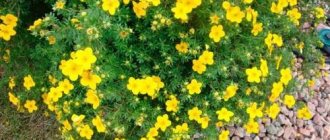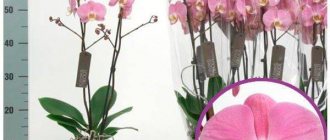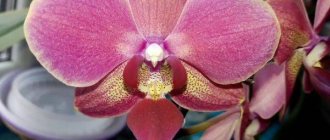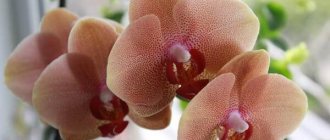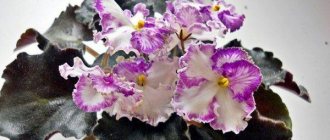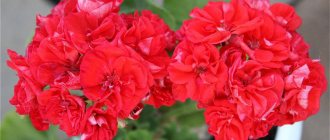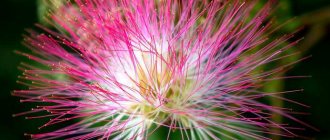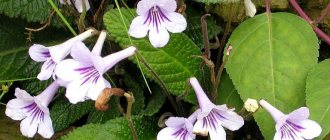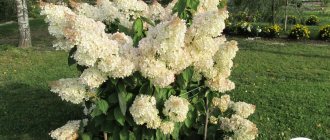It turns out that orchids of the genus Phalaenopsis differ not only in color, but also in the size of buds, leaves and peduncles, as well as the shape of flowers and the ability to produce several arrows at the same time. Based on these characteristics, about 70 species of this genus of orchids are distinguished. And there are even more varieties and hybrids!
Miniature and giant, with one or several peduncles, with regular or original bud shapes - that's all of them, phalaenopsis. And since it is so easy to get confused in them, we will allow ourselves to reflect the most accurate classification, indicating the most popular types and varieties.
Due to their popularity, some varieties and hybrids of phalaenopsis can be presented in several varieties at once.
Orchid Phalaenopsis mini
As is clear from the name of the variety, these plants are distinguished by their miniature size compared to other phalaenopsis plants. In particular, their leaves reach a length of no more than 15 cm, and thin peduncles do not grow higher than 20 cm. The diameter of the flowers barely reaches 5 cm, and maybe even less.
Phalaenopsis orchid Sogo Vivien
This orchid is distinguished by a miniature flower of regular shape and variegated foliage with light edging around the edges. The flowers are raspberry-lilac, variegated, equipped with a three-lobed divided curly lip (lower petal), distinguished by a slightly darker shade. The orchid has gained popularity due to its brightly colored buds. It blooms at any time of the year and very profusely.
Phalaenopsis orchid Mini dog
It is not entirely clear what relation this plant has to a small dog (and this is exactly what its name sounds like in literal translation), but it looks very presentable. Fragile buds are white with soft purple stripes and a plain dark lilac lip with a yellow speckled center. Mini Dog is distinguished by small leaves of a standard green color. Can bloom at any time of the year.
Phalaenopsis orchid Mini Mark
The plant is distinguished by medium green leaves about 10-15 cm long. The flowers are white with light orange, yellow or pink speckles, 3-4 cm in diameter. The lip is orange-brown. Mini Mark can bloom at any time of the year, but prefers the period from early November to early March.
Genus Platystele
This genus contains almost one hundred tiny species of orchids . Most of them have small flowers, and some are the smallest in the world.
Microscopic orchid Platystele stenostachya.
This genus is widespread in Mexico, Central America, the West Indies and South America in southern Bolivia, but is rare in Brazil.
The name was proposed by Schlechter in 1910 and comes from Greek and means wide column.
Typically, these plants are epiphytes, grow in cold and moderate temperature zones and develop at high altitudes, in humid cloud forests. They are characterized by:
- short stems with small clusters of flowers that open sequentially or simultaneously;
- the inflorescence emerges from the base of the plant;
- small flowers have sepals and free petals;
- the lip is simple and attached to the base of the column.
The smallest orchid of the genus Platystele has a flower about 2 mm in diameter, the petals of which are colorless and their thickness is one cell.
The plant was accidentally found in the roots of another orchid in a Bolivian nature reserve by the team of Lou Jost, an American botanist who has been studying orchids for several decades.
Orchid Phalaenopsis midi
Representatives of this variety grow larger than minis, but look much smaller than the standard. The leaves of midi orchids grow up to 20-25 cm in length, and peduncles grow up to 40 cm in height. Flowers reach 6-8 cm in diameter.
Phalaenopsis orchid Lueddemanniana
The light green, oval-shaped leaves of this plant harmonize well with pink or purple buds, whose shade becomes more saturated closer to the center. When opened, the flowers reach 6 cm in diameter. The plant is capable of producing arrows almost all year round, but is especially pleased with the abundance of flowering from December to March.
Phalaenopsis orchid Black mamba
A typical representative of phalaenopsis with blueberry (sometimes almost black) coloring of buds. The darker their color, the brighter the white border around the edge of the deep lilac petals. The lip is often lighter in color than the entire bud, and may have yellow spots on it. But the column (center of the flower) is almost always white. The plant can bloom long and profusely, at any time of the year. Several buds appear on the peduncle at the same time.
Orchid Phalaenopsis multiflora
This is a separate group of orchids, which may include different varieties. However, midi orchids most often tend to bloom this way. Multiflora implies the simultaneous flowering of several arrows of an orchid. In addition, they are prone to branching. If there is only one branching arrow, then most likely your plant lacks some elements of care, for example, fertilizing or lighting.
- How to make an orchid bloom at home - a cheat sheet for the gardener
The best time for an orchid is during its flowering period. But in order for it to delight you with new flower stalks, you need to know what conditions contribute to this.
Phalaenopsis orchid Big lip
This plant received its name for the unusual shape of the lip - fully expanded and almost no different in length from other petals. It has many varieties, one of which is Multiflora. Medium-sized buds can be painted in any color - plain or interspersed. Orchids belonging to this species produce several arrows at the same time, and all of them can boast of abundant flowering at any time of the year.
Phalaenopsis orchid Multiflora Santos
The rich green leaves of this plant contrast with the light lilac petals of the flowers. The lip is relatively small, slightly concave, pale or bright orange in color, with red splashes. The column is the same color as the bud, distinguished only by its pale orange tip. Capable of blooming at any time of the year, the dormant period is weak.
How to care for the variety?
Caring for phalaenopsis is not difficult, but, like every orchid, you need to find an approach. There will always be special techniques that speed up and prolong flowering or the formation of children for reproduction.
Choosing soil and pot
You need to select soil for phalaenopsis carefully and responsibly. The main requirements are maximum friability and high acidity (at least 5-6 units).
The substrate must consist of the following components:
- high peat;
- heather soil;
- pine sawdust;
- sand;
- a mixture of vermiculite and moss.
To ensure light access to the roots, pots with transparent walls are selected. Several drainage holes are made on the sides and in the bottom - one standard one is not enough.
In the wild, phalaenopsis grows directly on the bark of trees, so it only needs a pot as a support. The diameter of the container is selected in exact accordance with the size of the plant roots. A pot that is too large will cause water to stagnate and risk the plant rotting. In small ones, the roots will become crowded and they will be injured.
Reference. Recently, the method of growing phalaenopsis on special blocks sold in flower shops has gained popularity. These are fragments of pine bark to which the plant is attached with fishing line or rubber band. However, with this method of growing, the plant will have to pay more attention, since the roots quickly dry out and lose nutrients.
Landing
After selecting the pot and substrate, you can begin planting the phalaenopsis. The roots of the plant are fragile, so all actions are carried out with extreme caution:
- To carefully and easily remove the plant from the old container, do not water it for 2-3 days before the procedure. The orchid is removed from the pot. If it does not give in, the container is cut or broken. You cannot pull the flower out of the container: the roots stuck to the walls will come off.
- To dissolve the old, caked substrate, the roots are soaked in warm water for 20-30 minutes. The remains are cleaned with a wooden stick.
- Then the roots are dried for 1-2 hours, damaged or rotten ones are removed. The cut areas are sprinkled with charcoal or cinnamon.
- The bottom of the pot is filled to ¼ of the height with drainage. A little substrate is poured on top.
- To prevent the root collar from sinking into the substrate, before placing the plant in a pot, place a lump of coconut fiber or pieces of foam plastic in the center, between the roots. This will help position the growing point above the surface.
- The plant is placed in a planting container strictly vertically and the voids are filled with substrate, tapping the walls to compact the planting mixture.
Important! The substrate for filling the pot is slightly moistened. Phalaenopsis after planting is not watered for 7-10 days.
Watering and humidity
Regular and proper moistening of the substrate is the most important factor in plant care. A slight lack of moisture for this variety is preferable to waterlogging. On average, the plant requires watering 2 times a week in summer, and once every 10-15 days in winter. But before adding a new portion of moisture, it is better to pay attention to the condition of the plant.
Watering should be postponed if the following signs are observed:
- condensation is visible on the walls of the pot;
- aerial roots are directed to the sides of the stem;
- the main roots are light green.
Water the plant by immersing the pot in warm filtered or distilled water for 15-20 minutes. The roots will independently absorb the required amount of moisture, some of it will remain in the pieces of bark. Excess water is removed by placing the pot in a tray. As soon as all the excess liquid has drained, the pot is placed in a permanent place.
Gardeners have different opinions regarding indoor air humidity. Some argue that 40% is enough for phalaenopsis, others are confident that at least 60% is necessary. In any case, it is advisable to focus on the condition of a particular plant: if there is not enough moisture in the air, the leaves begin to turn yellow and the aerial roots lean toward the pot.
You can increase the humidity level in the following ways:
- install an automatic air humidifier or artificial fountain in the room;
- Spray the foliage with warm water;
- place the flower pot on a tray filled with water with expanded clay;
- During heating operation, hang wet towels on the radiators.
Spraying and watering of orchids is carried out only in the morning. If you moisten in the evening, the breathing of the plant roots will be disrupted.
Important! Experienced gardeners do not recommend spraying phalaenopsis to prevent water from getting into the center of the rosette. If there is a lack of moisture, it is better to wipe the leaves with a damp sponge or spray water near the plant.
Location and lighting
Choosing the right place to grow phalaenopsis is half the success. The most comfortable conditions:
- soft morning rays of sun on the east window;
- daylight hours from 12 to 16 hours;
- protection from burning light when located on southern windows (from 11.00 to 16.00).
On warm summer days, you can leave the orchid on the open balcony. With this arrangement, the plant will receive a sufficient amount of sunlight. Outside, there will be a natural difference in day and night temperatures, which will have a beneficial effect on the formation of buds and flowering.
Advice! To ensure that the phalaenopsis forms a rosette of leaves evenly and does not turn into a one-sided plant, the pot is turned 180 degrees every 2 weeks. But this should not be done during the formation of buds, otherwise the flowers will be dropped.
Temperature
Phalaenopsis is the most undemanding type of orchid in terms of temperature. The microclimate that is comfortable for him coincides with the atmosphere of an ordinary apartment.
Optimal indicators:
- +18… +25 °C throughout the year;
- the difference between day and night temperatures is about 5 degrees;
- slight “cooling” during the rest period.
Important! Phalaenopsis will tolerate a short-term drop in temperature to 10-15 degrees without difficulty. However, systematic maintenance at such indicators will lead to hypothermia and rotting of the roots.
Top dressing
Successful cultivation of phalaenopsis is impossible without regular and proper feeding. Experienced flower growers advise using special formulations for orchids, which balance all the substances necessary for the growth and development of the plant.
The following brands have proven themselves well:
- Dr. Foley. The main components are nitrogen and potassium, which promote tissue growth and the overall development of the orchid.
- Complex fertilizer Forte. The main component is phosphorus. It promotes bright and long-lasting flowering of the plant.
- Biocomplex Mister Color. A preparation for growing leaves and roots, forming flower stalks.
- Pokon. Concentrated fertilizer that can be used at all stages of plant development. Positively affects flowering and the formation of green mass.
- GreenWorld. Strengthens the roots and stem, improves the color of buds and leaves.
General rules for feeding phalaenopsis:
- Do not fertilize during active flowering. Accelerating metabolism under the influence of nutrients will shorten the life of the buds.
- Only healthy plants with an intact root system are fertilized. You cannot fertilize if the flower has just gotten sick or suffered from a pest attack.
- During the active growing season, fertilizing is carried out once every 10-14 days.
- After flowering, phalaenopsis continues to be fed for another 2 weeks in order to restore spent energy. During the dormant period, fertilizing is applied once every 2-3 weeks.
Carefully! The drugs are used in strict accordance with the instructions, avoiding overdose. Fertilize the plants only after preliminary watering, otherwise the roots will get burned and begin to rot.
Diseases and pests
Inappropriate care and violation of living conditions lead to the development of diseases. Diseases characteristic of orchids:
- Black rot - affects the roots when the flower is in the cold with high humidity. Treatment consists of removing the damaged areas with a sharp, disinfected instrument. The roots must be dried for 2 days. Then the plant is treated with a fungicide (Fundazol, Topsin-N) and planted in a fresh substrate.
- Bacterial spotting. Affects roots, leaves, peduncles and trunk. A characteristic feature is dark spots that gradually increase in size. When pressed, moisture releases from them. For treatment, the infected parts are cut off, and the wounds are lubricated with iodine or brilliant green. Additionally, the leaves are wiped with a solution of Metronidazole, Streptomycin, Tetracycline (1 tablet per 100 ml of water).
- Powdery mildew. The upper side of the leaves is covered with a white coating, the lower side is yellowish or brown. Fungal spores develop in a moist, warm environment. Treatment with Skor, Topsin-M, Forecast, and Topaz helps destroy pathogens.
- Sooty mushroom. A black coating forms on the leaves and roots, limiting access to sunlight and blocking photosynthesis processes. The disease is treated with Ridomil Gold, Skor, Mikosan, Topsin-M.
Numerous pests pose a great danger to orchids. The fight against them begins when the first signs appear, since if there is a delay, colonies of insects will populate all parts of the plant and cause significant harm to it.
The most common pests of phalaenopsis:
- Thrips are microscopic insects no more than 1.5 mm long. Ideal conditions for insect reproduction are dry air combined with a temperature of 25-30 degrees. Effective preparations for exterminating pests - Aktara, Vermitek.
- Shield. It mainly affects specimens that are weakened or overfed with nitrogen. It is difficult to destroy insects because they are covered with a strong shell that does not allow insecticides to penetrate the body. Therefore, parasites are cleaned from the plant with a cotton pad soaked in an alcohol solution. After mechanical cleaning, the phalaenopsis is given a hot shower.
- Mealybug. Colonies of pests look like cotton balls. They are located on all parts of plants, starting from the leaf axils. The pest is cleaned off mechanically, then washed off with warm water. The final stage is treatment with an insecticide.
- Spider and oribatid mites. An effective way to control these pests is to wash the foliage and roots with warm water.
- Aphid. The first sign of pest infestation is a white or sticky coating on the leaves. If it is detected, the plant is washed with soapy water. In case of mass infection, the flower is sprayed with Actellik, Alatar, Arrivo, Fitoverm.
Advice! You can detect pests in the roots without removing the plant from the pot by immersing it in a container with warm water. Some of the parasites will float up and can be examined.
Phalaenopsis standard
Taller, but not the largest specimens of orchids with leaves about 30-35 cm long and fairly strong peduncles up to 60 cm high. Large buds when opened reach 8.5-10 cm in diameter.
Orchid Anna White
The plant is distinguished by exclusively white large buds, which, when opened, can reach 10 cm in diameter, but can be smaller. The lip is two-lobed, with thin edges, has yellow blotches and small burgundy stripes located closer to the center. The column is white, with a slightly colored tip that matches the stripes. The leaves of this orchid are dark green. Sometimes, especially with plenty of light, they may develop a thin purple rim. It blooms profusely and for a long time, releasing several buds at the same time.
Orchid Wild cat
The Wild Cat orchid continues the fauna theme started in the mini-phalaenopsis section. In all respects, it should belong to the “standard” variety, however, with a lack of light, it grows much more slowly, and its flowers when opened do not reach the promised 10 cm, but stop at 8 cm. But in any case, the orchid looks gorgeous due to the flowers of cream or white with purple splashes. The lip is usually painted a lighter, solid color. Column of one color interspersed with a white tip. The plant can bloom at any time of the year.
Orchid Phalaenopsis Royal
This variety rightfully bears its name, since it looks like a real giant: the leaves of such plants reach up to 35 cm in length, and the peduncle is 70-90 cm in height. Large buds when opened reach 12-15 cm in diameter.
Phalaenopsis orchid Royal Pink
According to information from open sources, the name “Royal” can only be given to phalaenopsis marked Phalaenopsis Royal, bred in the Dutch nursery Geest Orchideeën (VG Orchids).
Royal orchids are famous for their different unusual shades of buds - from soft pink to blue and even greenish. However, in most cases this is the result of coloring the plant with special compounds. After the colored buds fall off, they are replaced by flowers of a real color (most often white).
Orchids of the “royal” variety are considered one of the most rare plants, and they are much more difficult to find on sale than other types. Only little-known species of orchids can compare with them in this regard.
- Little-known types of orchids - what they look like, how to grow them at home
If you have already mastered growing phalaenopsis and miltonias, take a closer look at rarer orchids.
Growing problems
Sometimes when growing orchids, gardeners encounter various problems.
The leaves are getting smaller
If phalaenopsis leaves become smaller, then most likely there are problems with the roots:
- perhaps the composition of the substrate is incorrectly selected;
- roots were damaged during transplantation or improper watering.
Such a plant can be placed in a greenhouse or re-rooted.
No flowering
There may be several reasons for this:
- insufficient illumination of the plant;
- the plant is overfed with nitrogen fertilizer;
- waterlogging of the substrate.
Almost all types of orchids begin to bloom at the end of the growing season.

